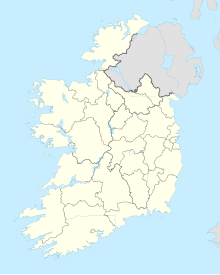
Summary
Sligo Airport (Irish: Aerfort Shligigh) is located in Strandhill, County Sligo, 5 NM (9.3 km; 5.8 mi)[1] west of Sligo, at the end of the R277 road, in Ireland. The airport is a small regional airport and has had no scheduled routes since 2011. It is the home of the Sligo Aero Club (a Registered Training Facility) and the northwest base for the Irish Coastguard. Private flight training, skydiving and charity jumps are all operated from the airport. In 2002 a Euroceltic Airways Fokker F27 aircraft carrying the band Aslan overshot the runway and the nose dipped into the sea. The accident caused no casualties.
Sligo Airport Aerfort Shligigh | |||||||||||
|---|---|---|---|---|---|---|---|---|---|---|---|
 Sligo Airport | |||||||||||
| Summary | |||||||||||
| Airport type | Public | ||||||||||
| Operator | Sligo Northwest Airport Co Ltd | ||||||||||
| Serves | Sligo , Ireland | ||||||||||
| Location | Strandhill, County Sligo | ||||||||||
| Elevation AMSL | 11 ft / 3 m | ||||||||||
| Coordinates | 54°16′49″N 008°35′57″W / 54.28028°N 8.59917°W | ||||||||||
| Website | www.sligoairport.com | ||||||||||
| Map | |||||||||||
 SXL Location of airport in Ireland | |||||||||||
| Runways | |||||||||||
| |||||||||||
History edit
As of 2002, Euroceltic was operating the Government of Ireland public service obligation subsidy scheme for the route to Dublin. The airline collapsed shortly afterwards and Aer Arann operated the route for the remainder of the contract. The 2005 contract tender was offered to Loganair who declined it. Aer Arann subsequently negotiated the operation of the contract with the Government.
On 21 February 2007 the Irish Government announced that it would be giving €8.5 million to the airport in capital grant money, to upgrade the runway and add approach lighting and safety enhancements. However, the proposed runway extension would have required infill and the erection of gantries across part of the adjacent protected beach. The plan drew much local criticism and almost 400 objections from residents of the local area, fisheries groups, the Department of Environment, An Taisce and Birdwatch Ireland. The planning permission was quashed on the third attempt by a high court judge on justification grounds.[2]
Until the end of 2008 Aer Arann operated flights to Manchester Airport. In 2011 the airport lost its only scheduled route, operated by Aer Arann, to Dublin Airport twice daily. The final flight was on 21 July 2011.
The Irish Government-commissioned Value for Money Review of Exchequer Funding on the Regional Airports Programme recommended the ending of operational subvention to the airport and the ending of the PSO designation, citing poor performance, growing operational costs and development of alternative transport connections to the region.[3]
Since the end of passenger flights in 2011, the airport has continued to be a base for the Irish Coast Guard Rescue Helicopter (Rescue 118). General aviation also operates at the airport, including aircraft such as Cessnas, Pipers, and Beechcraft. Sligo Aero Club continues to operate from the airport. The airport receives occasional visits from jets which are suited to land on the shorter runway.
CHC Ireland Search-and-Rescue base edit
Sligo Airport is the home of Rescue 118, the Irish Coast Guard Helicopter which has served the north-west of Ireland since 2004. The base operates a Sikorsky S-92A helicopter 24 hours, 365 days a year (which replaced the previously used S-61N on 1 July 2013). It deals with many types of incidents, such as cliff rescues, hospital transfers and dealing with sick patients off coastal islands.
Accidents and incidents edit
Like airports such as Gibraltar and Funchal, Sligo has a lack of safety margin for undershoots and overshoots because the peninsula upon which the airport is situated is less than 2 km (1.2 mi) long. On 2 November 2002, a Euroceltic Fokker F-27 (registered G-ECAT) was coming in to land, after a routine flight from Dublin, when it overran the runway. After landing nosewheel first almost halfway down the runway, the aircraft eventually came to rest with the nose of the aircraft in the sea, and the main landing gear on an embankment. Passengers were evacuated and there were no reported casualties. However the plane was declared a write-off by the company two weeks later, due to the saltwater damage to the cockpit. The cause of the accident was a "fast, low approach, leading to the aircraft landing late, beyond the normal touch down point, thereby making it impossible to stop the aircraft on the remaining runway available". The pilot at the time had been placed under restrictions following a CAA audit of Euroceltic, as noted in paragraph 1.18.2 of the AAIU report. The chief pilot of Euroceltic "was using an instructor tone and coaching" the pilot during landing, as noted in paragraph 2.1 of the report. The AAIU report also notes in paragraph 2.1 that "Whilst the meteorological conditions were difficult they were well within the limits for the type of approach and there was very little crosswind component" and in paragraph 2.2 that "there was no significant standing water on the runway during the landing".[4]
References edit
- ^ a b EISG – SLIGO (PDF). AIP and charts from the Irish Aviation Authority.
- ^ http://www.dorrins.com/latest-news/2010/06/high-court-quashes-airport-planning-decision/[permanent dead link]
- ^ "Value for Money Review of Exchequer Funding on the Regional Airports Programme". Department of Transport. 28 January 2011. Archived from the original on 1 February 2011. Retrieved 15 August 2011.
- ^ "AAIU Formal Report No: 2005-015" (PDF). Air Accident Investigation Unit. 25 August 2005. Archived (PDF) from the original on 30 September 2017. Retrieved 30 September 2017.
External links edit
Media related to Sligo Airport at Wikimedia Commons
- Official website


